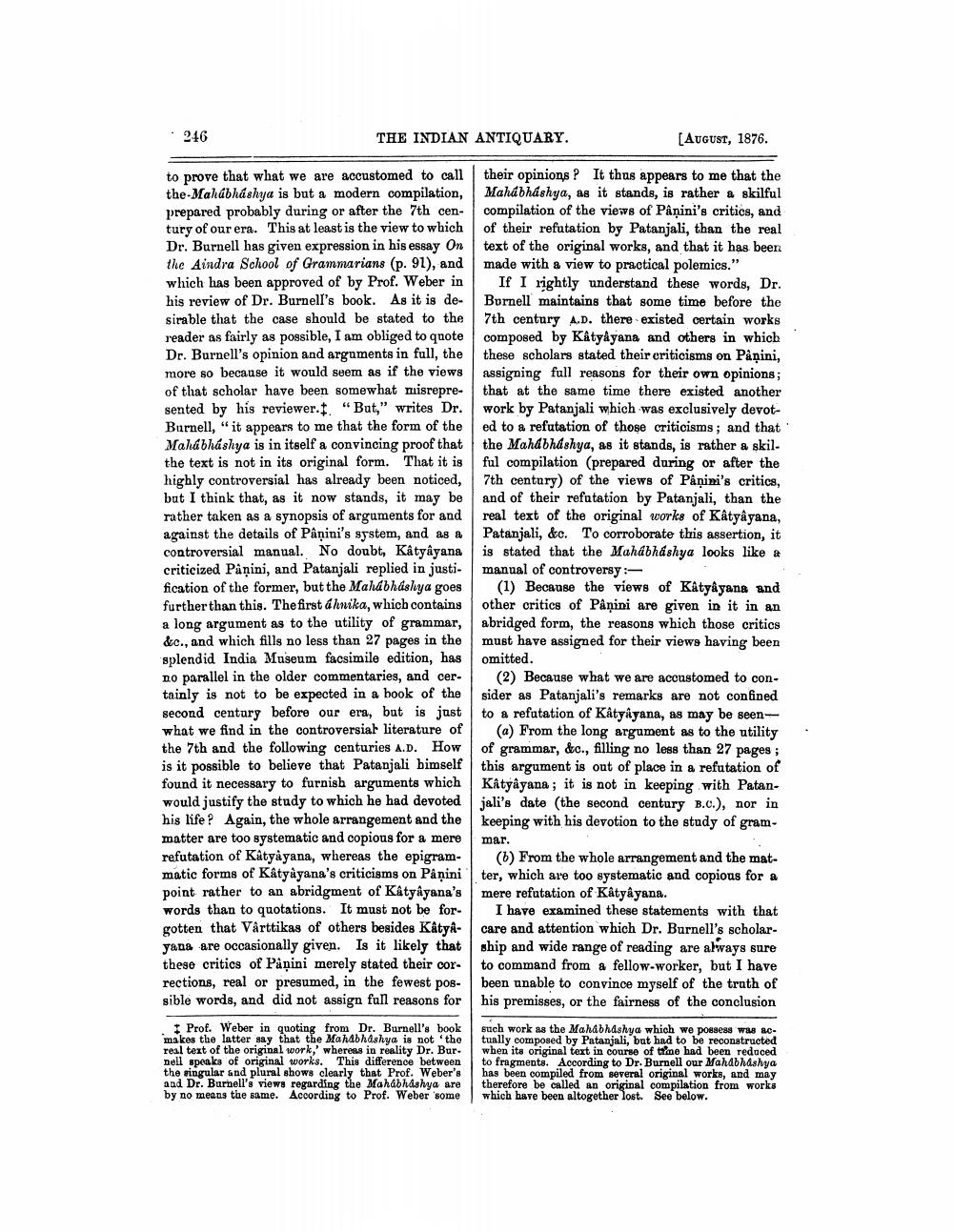________________
246
THE INDIAN ANTIQUARY.
to prove that what we are accustomed to call the-Mahabhashya is but a modern compilation, prepared probably during or after the 7th century of our era. This at least is the view to which Dr. Burnell has given expression in his essay On the Aindra School of Grammarians (p. 91), and which has been approved of by Prof. Weber in his review of Dr. Burnell's book. As it is desirable that the case should be stated to the reader as fairly as possible, I am obliged to quote Dr. Burnell's opinion and arguments in full, the more so because it would seem as if the views of that scholar have been somewhat misrepresented by his reviewer.‡. "But," writes Dr. Burnell, "it appears to me that the form of the Mahabhashya is in itself a convincing proof that the text is not in its original form. That it is highly controversial has already been noticed, but I think that, as it now stands, it may be rather taken as a synopsis of arguments for and against the details of Pânini's system, and as a controversial manual. No doubt, Kâtyâyana criticized Panini, and Patanjali replied in justification of the former, but the Mahabhashya goes further than this. The first áhnika, which contains a long argument as to the utility of grammar, &c., and which fills no less than 27 pages in the splendid India Museum facsimile edition, has no parallel in the older commentaries, and certainly is not to be expected in a book of the second century before our era, but is just what we find in the controversial literature of the 7th and the following centuries A.D. How is it possible to believe that Patanjali himself found it necessary to furnish arguments which would justify the study to which he had devoted his life? Again, the whole arrangement and the matter are too systematic and copious for a mere refutation of Katyayana, whereas the epigrammatic forms of Katyayana's criticisms on Pânini point rather to an abridgment of Kâtyâyana's words than to quotations. It must not be forgotten that Vârttikas of others besides Kâtyâyana are occasionally given. Is it likely that these critics of Panini merely stated their corrections, real or presumed, in the fewest possible words, and did not assign full reasons for
Prof. Weber in quoting from Dr. Burnell's book makes the latter say that the Mahabhashya is not 'the real text of the original work,' whereas in reality Dr. Burnell speaks of original works. This difference between the singular and plural shows clearly that Prof. Weber's and Dr. Burnell's views regarding the Mahabhashya are by no means the same. According to Prof. Weber some
[AUGUST, 1876.
their opinions? It thus appears to me that the Mahábháshya, as it stands, is rather a skilful compilation of the views of Pânini's critics, and of their refutation by Patanjali, than the real text of the original works, and that it has been made with a view to practical polemics."
If I rightly understand these words, Dr. Burnell maintains that some time before the 7th century A.D. there existed certain works composed by Katyayana and others in which these scholars stated their criticisms on Panini, assigning full reasons for their own opinions; that at the same time there existed another work by Patanjali which was exclusively devoted to a refutation of those criticisms; and that the Mahabhashya, as it stands, is rather a skilful compilation (prepared during or after the 7th century) of the views of Panini's critics, and of their refutation by Patanjali, than the real text of the original works of Kâtyâyana, Patanjali, &c. To corroborate this assertion, it is stated that the Mahabháshya looks like a manual of controversy:
(1) Because the views of Katyayana and other critics of Pânini are given in it in an abridged form, the reasons which those critics must have assigned for their views having been omitted.
(2) Because what we are accustomed to consider as Patanjali's remarks are not confined to a refutation of Katyayana, as may be seen
(a) From the long argument as to the utility of grammar, &c., filling no less than 27 pages; this argument is out of place in a refutation of Kâtyâyana; it is not in keeping with Patanjali's date (the second century B.C.), nor in keeping with his devotion to the study of grammar.
(b) From the whole arrangement and the matter, which are too systematic and copious for a mere refutation of Kâtyâyana.
I have examined these statements with that care and attention which Dr. Burnell's scholarship and wide range of reading are always sure to command from a fellow-worker, but I have been unable to convince myself of the truth of his premisses, or the fairness of the conclusion
such work as the Mahabhashya which we possess was actually composed by Patanjali, but had to be reconstructed when its original text in course of time had been reduced to fragments. According to Dr. Burnell our Mahabhashya has been compiled from several original works, and may therefore be called an original compilation from works which have been altogether lost. See below.




